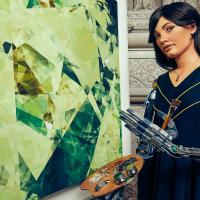Frederick Douglass was the most photographed man of the 19th century, with 160 photographs in existence today. The fugitive slave turned abolitionist was more photographed during that time than General Custard, Ulysses S. Grant, and even President Abraham Lincoln.
Frederick Douglass saw purpose and intention in capturing his own image and sharing it with the masses. To him, portraits were a means of self-expression that held the power to lift himself and an entire race of people out of the oppression they faced.
Today, vanity and narcissism are commonly associated with selfie culture. When you see someone raising their phone high overhead to capture that perfectly-angled, duck-lipped photo, it’s unlikely that your first thought is: hero.
What is the real driving force behind these images we create of ourselves, and why is so much of our time dedicated to capturing that perfect shot? We can look to Frederick Douglass for the answer, a man who, though revered for his selfless dedication to the cause of his people, placed great value in something so seemingly vain.
Who was Frederick Douglass?
Frederick Douglass is one of the most influential figures in history. Born into slavery in Maryland in 1818, he escaped at the age of 20 and dedicated the rest of his life to lifting his people out of the injustice that so many were born into.
Douglass recognized that the way African Americans were most often depicted was by its very nature dehumanizing, and it was fueling their mistreatment.
In order to change the perception of his people, Douglass assumed the responsibility of taking control of their image. To help end slavery, he knew that he had to challenge the insidious, racist perception of those who were enslaved. Through his portraits, he sought to accurately represent both his identity and the identity of all Black people.
Inspiring Frederick Douglass Facts
A number of historical accounts point to the attention to detail that Frederick Douglass paid to his pictures. These images couldn’t be haphazardly taken and distributed; they needed to be purposeful.
Douglass studied the technological craft of photography along with its emotional effect on viewers. He refused to allow himself to be portrayed as a happy and amiable, fugitive slave but instead, as a man undeniably worthy of freedom and citizenship.
His photographs allowed him to control his identity and be seen as a human on equal footing with White men. For Frederick Douglass, and many today, the selfie represented the ability to show the world how we see ourselves and in turn, change how they see us.
Along with the intentional act of taking pictures, Douglass had a very clear and intricate understanding of the “social networking” that was available to him in the 19th century. In that era, this meant printing his photos and getting them seen by as many people as possible.
Douglass would give away pictures of himself en masse and the recipients would hang the picture on their wall, next to photos of family and friends. In doing so, he helped African Americans take control of their own identity. His portraits challenged the depiction of African Americans as sub-humans, underserving of equality.
The Power of a Photograph
Through his pictures, Frederick Douglass had a profound impact on how Black men and women were perceived. When viewing selfies through this lens, we can begin to recognize their true power. These pictures aren’t simply a vapid attempt at capturing a momentary expression, but instead a decision to express oneself and influence how others perceive you.
Today, there are more than five billion people with cell phones and more than three billion on some form of social media. With so many people taking and sharing pictures, the selfies have understably become viewed as frivolous. But an incredible amount of thought and care goes into how individuals portray themselves purposefully on their Instagram profiles.
Through its ability to help humans create their sense of self, the selfie might be one of the most important cultural movements in our history. More people than ever before now have the ability to portray themselves as they wish to be seen.
Trans men and women, individuals with diverse physiology, teens and seniors all over the world now have the ability to tell their own story. Frederick Douglass laid the blueprint for how we use these images to show others how we should be viewed.
One example is Janna Garza, an artist based in Austin, Texas who was diagnosed with Polymyositis- a progressive muscle-wasting disease- in 2015. Worried about being perceived as sick, Janna saw selfies as a way out.
“I was on a lower dosage of chemo than most people, like cancer patients for example, but then my hair just started falling out in clumps. One night I decided to shave it. I took a picture of myself that night and I think that’s the night that my self-portraits began,” Janna recalls.
The selfie movement gave Janna an avenue for controlling her image, allowing her to represent herself as she wanted to be seen. In speaking of her portraits, Janna shared, “my illness doesn’t live there.”
Likewise, Frederick Douglass took portraits to control his identity, and he made a way for the following generations to do the same. He was the most photographed man of the 19th century, not out of vanity but out self-expression and purpose.
For more interesting news about the people and ideas that are changing our world, subscribe to Freethink.


